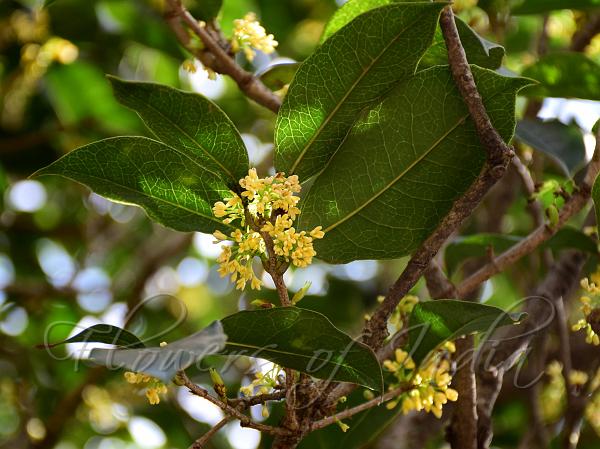|
| Fragrant Olive |
|

|

| File size | 632096 |
| Original date | 2/8/17 2:18 PM |
| Resolution | 2048 x 1536 |
| Flash | Flash did not fire |
| Focal length | 66.0mm |
| Exposure time | 1/320s |
| Aperture | 5.0 |
| Focus Distance | |
| Metering Mode | Spot |
| Camera make | NIKON CORPORATION |
| Camera model | NIKON D5300 |
| Sensor type | OneChipColorArea |
|
|
|
|
Photo: |
Botanical name: Osmanthus fragrans Family: Oleaceae (Jasmine family)
Synonyms: Olea fragrans var. lutea, Olea ovalis
Synonyms: Olea fragrans var. lutea, Olea ovalis
Fragrant Olive is an evergreen shrub or small tree
growing up to 3-12 m tall. The leaves are 7-15 cm long and 2.6-5 cm
broad, with an entire or finely toothed margin. The flowers are white,
pale yellow, yellow, or orange-yellow, small (1 cm long), with a
four-lobed corolla 5 mm diameter, and have a strong fragrance; they are
produced in small clusters in the late summer and autumn. The fruit is
a purple-black drupe 1.0-1.5 cm long containing a single hard-shelled
seed; it is mature in the spring about six months after flowering. It
is cultivated as an ornamental plant in gardens in Asia, Europe, North
America, and elsewhere in the world for its deliciously fragrant
flowers which carry the scent of ripe peaches or apricots. In Chinese
cuisine, its flowers may be infused with green or black tea leaves to
create a scented tea. Fragrant Olive is found in temperate Himalaya, at
altitudes of 1200-3000 m, from Garhwhal to Sikkim, China, Japan.
Flowering: September-October.
Medicinal uses: In traditional Chinese
medicine, osmanthus tea has been used as an herbal tea for the
treatment of irregular menstruation. The extract of dried flowers
showed neuroprotective, free-radical scavenging, antioxidative effects
in in vitro assays. It is also used in Ayurveda.
In traditional Chinese
medicine, osmanthus tea has been used as an herbal tea for the
treatment of irregular menstruation. The extract of dried flowers
showed neuroprotective, free-radical scavenging, antioxidative effects
in in vitro assays. It is also used in Ayurveda.
Medicinal uses:
 In traditional Chinese
medicine, osmanthus tea has been used as an herbal tea for the
treatment of irregular menstruation. The extract of dried flowers
showed neuroprotective, free-radical scavenging, antioxidative effects
in in vitro assays. It is also used in Ayurveda.
In traditional Chinese
medicine, osmanthus tea has been used as an herbal tea for the
treatment of irregular menstruation. The extract of dried flowers
showed neuroprotective, free-radical scavenging, antioxidative effects
in in vitro assays. It is also used in Ayurveda. | Identification credit: Amber Srivastava | Photographed in Dehradun, Uttarakhand. |
• Is this flower misidentified? If yes,